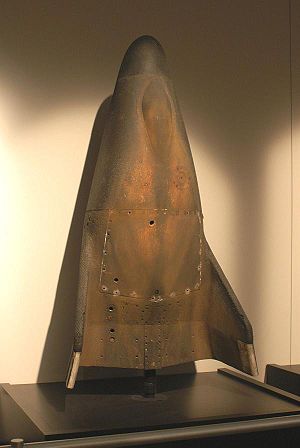Martin X-23 PRIME
| X-23 PRIME | |
|---|---|

| |
| Preserved X-23 PRIME at USAF Museum, Dayton, Ohio | |
| Role | Lifting body |
| Manufacturer | Martin Marietta |
| First flight | 21 December 1966 |
| Retired | 19 April 1967 |
| Status | Out of service |
| Primary user | United States Air Force |
| Number built | 3 |
| Variants | Martin X-24 |
The Martin X-23A PRIME (Precision Reentry Including Maneuvering reEntry) was a small lifting body re-entry vehicle tested by the United States Air Force in the mid-1960s. Unlike ASSET, primarily used for structural and heating research, the X-23 PRIME was developed to study the effects of maneuvering during re-entry of Earth's atmosphere, including cross-range maneuvers up to 710 statute miles (1143 km) off of the ballistic track.
Design
Each X-23 was constructed from titanium, beryllium, stainless steel, and aluminium. The craft consisted of two sections — the aft main structure and a removable forward "glove section." The structure was completely covered with a Martin-developed ablative heat shield 20 to 70 mm (¾ to 2¾ inches) thick, and the nose cap was constructed of carbon phenolic material.
Aerodynamic control was provided by a pair of 12-inch (30 cm) square lower flaps, and fixed upper flaps and rudders. A nitrogen gas reaction control system was used outside the atmosphere. At Mach 2 a drogue ballute deployed and slowed the vehicle's descent. As it deployed, its cable sliced the upper structure of the main equipment bay, allowing a 47-foot (16.4 m) recovery chute to deploy. It would then be recovered in midair by a specially-equipped JC-130B Hercules aircraft.
Flight testing
The first PRIME vehicle was launched from Vandenberg AFB on 21 December 1966 atop an Atlas launch vehicle. This mission simulated a low-earth orbit reentry with a zero cross-range. The ballute deployed at 99,850 feet (30.43 km), though the recovery parachute failed to completely deploy. The vehicle crashed into the Pacific Ocean.
The second vehicle was launched on 5 March 1967. This flight simulated a 654-mile (1053-kilometre) cross range re-entry, and banking at hypersonic speeds. Several stringers on the main parachute failed to cut, preventing a successful recovery. It too was lost in the Pacific.
The final PRIME mission was flown on 19 April 1967, and simulated reentry from low-earth orbit with a 710-mile (1143-kilometre) cross-range. This time, all systems performed perfectly, and the X-23 was successfully recovered. An inspection by a USAF-Martin team reported the craft "ready to fly again," although no later missions were carried out. The third X-23 is now on display at the National Museum of the United States Air Force at Wright-Patterson Air Force Base in Ohio.
Specifications (X-23)
| This aircraft article is missing some (or all) of its specifications. If you have a source, you can help Wikipedia by adding them. |
General characteristics
- Crew: None
Performance
- Hypersonic L/D Ratio: 1:1
See also
Aircraft of comparable role, configuration, and era
Molniya BOR-4
ASSET
